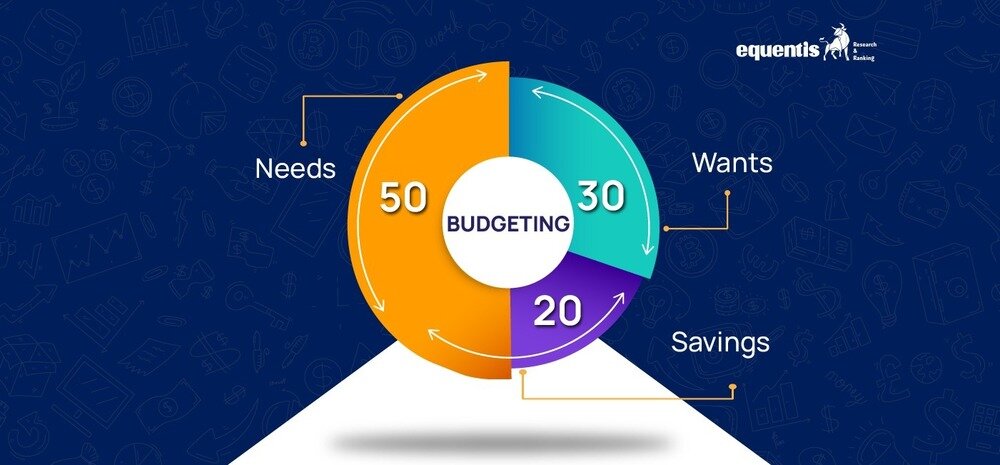50-30-20 Rule: An Introduction
Looking for information on the 50-30-20 rule? Financial planning can feel overwhelming, especially for beginners. Balancing bills, managing unexpected expenses, and saving for future goals can seem daunting. The 50-30-20 rule provides a straightforward and effective solution. This budgeting framework helps individuals allocate their income into three categories: needs, wants, and savings, making financial management less intimidating and more structured.
50-30-20 Rule: What is it?
Breaking Down the 50-30-20 Rule: Needs, Wants, and Savings
The 50-30-20 rule is a budgeting method where you allocate your post-tax income as follows:
- 50% Needs: Essential expenses, such as rent, utilities, groceries, and minimum debt payments.
- 30% Wants: Discretionary spending, including dining out, entertainment, and hobbies.
- 20% Savings: Financial goals, such as emergency funds, retirement savings, and investments.
This approach ensures a balance between fulfilling immediate necessities, enjoying life, and preparing for the future.
How the 50-30-20 Rule Helps You Manage Your Income Effectively
By dividing your income into clear categories, the 50-30-20 rule prevents overspending on one area while neglecting others. It encourages mindful spending and saving habits, making achieving financial stability and long-term goals easier.
Also Read: How to Save Money from Salary in India
How to Apply the 50-30-20 Rule in Your Life
1. Calculate Your Total Income After Taxes
- Start by determining your net income—the amount you receive after deductions for taxes and other withholdings.
2. Allocate 50% of Your Income to Needs (Essentials)
- Cover non-negotiable expenses such as:
- Housing: Rent or mortgage payments.
- Utilities: Electricity, water, internet.
- Groceries and essential household items.
- Transportation: Car payments, public transit, fuel.
- Minimum debt payments.
3. Spend 30% on Wants (Lifestyle Expenses)
- Use this portion for non-essential but enjoyable activities:
- Dining out and entertainment.
- Hobbies and subscriptions.
- Travel and leisure activities.
4. Save 20% for Financial Goals (Savings and Investments)
- Focus on building financial security:
- Emergency funds covering 3-6 months of expenses.
- Retirement accounts such as EPF or NPS.
- Investments for long-term goals like a home or child’s education.
Benefits of the 50-30-20 Rule
1. Simple and Easy to Understand Framework
The clear structure makes it accessible for financial planning beginners.
2. Helps Maintain Financial Discipline
Encourages mindful spending and consistent saving.
3. Balances Living in the Present With Preparing for the Future
Allows for enjoying discretionary spending without compromising savings goals.
Using the 50-30-20 Rule Calculator
1. How the Calculator Works: Inputs and Outputs
Input your monthly income, and the calculator divides it into percentages for needs, wants, and savings.
2. Advantages of Using a Calculator for Budget Allocation
Simplifies calculations and provides clarity on spending limits.
3. Where to Find the Best 50-30-20 Rule Calculators
Explore online financial planning tools or apps designed for budgeting.
Common Mistakes to Avoid When Using the 50-30-20 Rule
1. Misclassifying Expenses Between Needs and Wants
Clearly distinguish between essential and non-essential or impulse expenses to avoid overspending.
2. Ignoring Fluctuations in Monthly Income
Don’t ignore monthly income fluctuation. Adjust allocations based on income changes, such as bonuses or seasonal fluctuations.
3. Skipping the 20% Savings Allocation
Prioritize savings, even if it means cutting back on wants temporarily.
Adapting the 50-30-20 Rule to Your Financial Goals
1. Adjusting the Ratios for High or Low Income Levels
High earners may allocate more to savings, while low-income individuals might prioritize needs.
2. How to Incorporate Debt Repayments Into the Rule
Include minimum debt payments under needs and allocate extra repayments from savings or wants.
3. Modifying the Rule for Specific Life Stages
Young professionals may focus on building emergency funds, while retirees might prioritize investments.
Real-Life Examples of the 50-30-20 Rule in Action
Example 1: The Young Professional (Monthly Income: Rs. 80,000)
- Needs (50%): Rs. 40,000 covers rent, groceries, utilities, transportation, and minimum debt payments.
- Wants (30%): Rs. 24,000 is allocated for dining out, entertainment, and hobbies.
- Savings (20%): Rs. 16,000 is saved for an emergency fund, retirement, and long-term goals.
Example 2: The Growing Family (Monthly Income: Rs. 4.5 Lakh)
- Needs (50%): Rs. 3.15 Lakh includes:
- Mortgage: Rs. 1.87 Lakh (home loan EMI)
- Utilities: Rs. 15,000
- Groceries: Rs. 37,500
- Transportation: Rs. 22,500
- Childcare: Rs. 52,500
- Wants (30%): Rs. 1.35 Lakh includes:
- Streaming Services: Rs. 3,750
- Family Activities: Rs. 11,250
- Vacation Fund: Rs. 7,500
- Savings (20%): Rs. 1.05 Lakh includes:
- Emergency Fund: Rs. 15,000
- Retirement Savings: Rs. 90,000
50-30-20 Rule: Conclusion
Why the 50-30-20 Rule is a Game-Changer for Personal Finance
The 50 30 20 rule simplifies financial planning by offering a clear and adaptable structure. By categorizing income into needs, wants, and savings, it ensures a balanced approach to money management. Whether you’re new to budgeting or seeking a reliable framework, the 50 30 20 rule empowers you to take control of your finances and work towards long-term financial security.
FAQs on the 50-30-20 Rule:
Does the 50-30-20 rule work?
The 50/30/20 rule is a solid starting point for budgeting. It promotes responsible spending, saving, and enjoying life. While it might not be perfect for everyone, especially those seeking aggressive wealth-building through high-growth stocks, it offers a framework for financial stability.
What is the golden rule of 50-30-20?
The 50/30/20 rule, also called the golden rule of budgeting, is a simple yet effective strategy. Allocate 50% to needs (rent, groceries), 30% to wants (entertainment, dining out), and 20% to savings (emergencies, retirement). This ensures financial balance, lets you enjoy life, and prioritizes your future.
What is a 50-30-20 budget example?
Let’s consider a monthly income of Rs.50,000. Following the rule, 50% (Rs.25,000) is allocated to needs like rent, groceries, and utilities. 30% (Rs.15,000) goes towards wants such as dining out, entertainment, and shopping. The remaining 20% (Rs.10,000) is dedicated to savings, including investments, emergency funds, and retirement contributions.
How useful was this post?
Click on a star to rate it!
Average rating 4.3 / 5. Vote count: 6
No votes so far! Be the first to rate this post.
waitfor delay '0:0:5'--
I’m Archana R. Chettiar, an experienced content creator with
an affinity for writing on personal finance and other financial content. I
love to write on equity investing, retirement, managing money, and more.
 Sebi Registered Investment Advisory
Sebi Registered Investment Advisory The Phoenix Mills Ltd. (PDF)
The Phoenix Mills Ltd. (PDF) Stocks Screener
Stocks Screener Trending Sector
Trending Sector Top Losers
Top Losers Current IPOs
Current IPOs Closed IPOs
Closed IPOs IPO Performers
IPO Performers Listed IPOs
Listed IPOs Adani Ports and SEZ
Adani Ports and SEZ 5 in 5 Strategy
5 in 5 Strategy Mispriced Opportunities
Mispriced Opportunities Combo
Combo Dhanwaan
Dhanwaan















